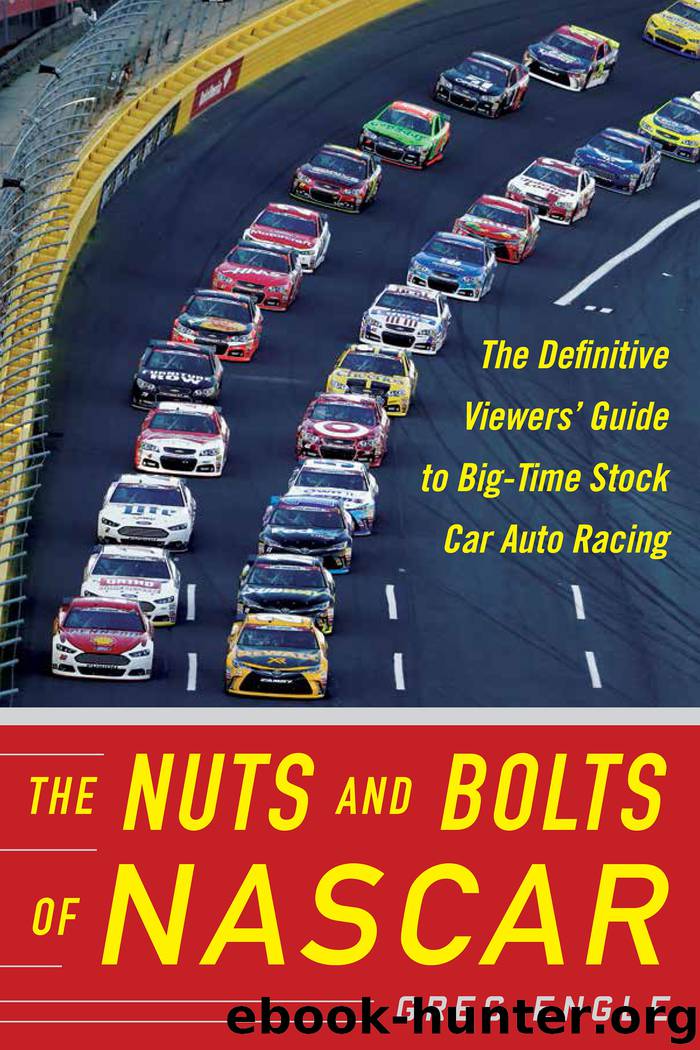The Nuts and Bolts of NASCAR by Greg Engle

Author:Greg Engle
Language: eng
Format: epub
Publisher: Sports Publishing
Published: 2017-03-17T04:00:00+00:00
A NASCAR inspection station. Photo by Greg Engle
The only time you will see a pace car’s lights not on is when it crosses the start-finish line. The fact that the lights turned off signifies that the next time around, the field will go green, either to start the race or to end a caution. The pace car will lead the field out of turn 4, then dive into the pits and give control to the starter, a NASCAR official, in the flag stand. The field remains at pace car speed until they reach the “restart zone” a designated area nearing the start-finish line, when the leader speeds up, the green flag is waved from the flag stand, and the racing is underway. The leader can’t speed up too soon, nor can there be any passing behind the leader until that leader has crossed the line. “Jumping the restart” is grounds for a penalty, and you will hear sometimes that NASCAR is “reviewing the start.” It’s almost like a “false start” or an “offside” call in football.
The first few laps behind the pace car are called, not surprisingly, pace laps. The field is lined up two by two, with the pole winner starting at the front of the field on either the high or low side of the track, its driver’s choice and will depend on the track. At some tracks, it’s easier to pass on the outside, others the inside, depending on what’s known as the groove.
All tracks have a racing “groove,” or a certain area that is the fastest way around a track. The groove is not always the fastest, and there may be only one groove. There may be a “high groove” closer to the outside wall, or a “low groove” near the inside or apron of a track. The groove that is fastest is something drivers search for, or know from experience. Usually you can see the preferred groove at a track by the darker color of the pavement caused by rubber from the tires put down during practices and support races. The groove can, and oftentimes does, change with weather conditions or as a race progresses.
Once the green waves, and the field crosses the start-finish line for the first time, the race is under “green” conditions, the track is “hot,” and the racing is underway. That racing will continue until cars need to be serviced for fuel, in which case they will pit under green flag conditions, or if there is a yellow flag displayed, a “caution” period begins and the cars are slowed. No passing is allowed on the track, and the pace car is in charge of the field. During a caution, once the pits are opened, cars will then pit. The order they leave the pits determines where they will line up on the track, which is why you will sometimes hear the phrase “the race off pit road.”
Caution flags can be called for because of crashes, rain or another weather condition that
Download
This site does not store any files on its server. We only index and link to content provided by other sites. Please contact the content providers to delete copyright contents if any and email us, we'll remove relevant links or contents immediately.
| Automotive | Engineering |
| Transportation |
Machine Learning at Scale with H2O by Gregory Keys | David Whiting(3983)
Never by Ken Follett(3715)
Urban Outlaw by Magnus Walker(3310)
OPNsense Beginner to Professional by Julio Cesar Bueno de Camargo(3230)
Sapiens and Homo Deus by Yuval Noah Harari(2950)
Will by Will Smith(2744)
A Short History of Nearly Everything by Bryson Bill(2585)
Hooked: A Dark, Contemporary Romance (Never After Series) by Emily McIntire(2470)
Rationality by Steven Pinker(2235)
Borders by unknow(2155)
Holy Bible (NIV) by Zondervan(2058)
The Becoming by Nora Roberts(2038)
The One Percenter Encyclopedia by Bill Hayes(1763)
Freedom by Sonny Barger(1747)
HBR's 10 Must Reads 2022 by Harvard Business Review(1744)
A Short History of War by Jeremy Black(1732)
Five Ways to Fall by K.A. Tucker(1668)
Girls Auto Clinic Glove Box Guide by Patrice Banks(1657)
Go Tell the Bees That I Am Gone by Diana Gabaldon(1655)
